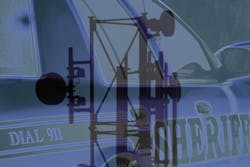Congress approves D-block reallocation with payroll tax cut extension
As a part of the payroll tax cut extension passed last week by Congress, the band of radio spectrum known as "D-block" (758 megahertz to 763 megahertz and between 788 megahertz to 793 megahertz) was officially reallocated for use by public safety agencies.
Though it was a recommendation of the 9/11 Commission, the creation of an interoperable public safety network for first responders had stalled in both the House and the Senate as lawmakers were divided on how exactly to fund it.
Under the Middle Class Tax Relief and Job Creation Act of 2012, $7 billion will be set aside in a trust fund for the construction of the network. This money will be raised through the auctioning of spectrum currently owned by television broadcasters.
Initially, however, the National Telecommunications and Information Administration, which has be charged with oversee the construction of the network, will be allowed to borrow up to $2 billion from the Treasury for the project.
"The way public safety does business is going to change forever in a positive way," said Richard Mirgon, past president of the Association of Public-Safety Communications Officials (APCO) International. "We are going to have tools and technology that directly saves people's lives."
The next step, according to Mirgon, will be getting the ball rolling on the actual build out of the network and all that that will entail.
"Building out a nationwide framework for an interoperable data network is just huge," he said. "So having the federal government setup a governing board and having them get to work in developing the strategy, the RFPs in conjunction with the states to actually start construction of this network is the first key step and that's a lot of work in itself. But, the actual build out and all the agreements that have to be reached with local carriers, people providing backbone, and the states and local governments using the network is just a huge amount of work. It will take a few years."
Mirgon said he expects it will take at least 10 years to complete the build out of the network with the first construction to begin within 18 months.
"I've been working on changing the way we allocate spectrum for a long time because a smarter system is good for our economy, good for innovation, and vital to keeping our communities as well as our cops, firefighters and EMTs safe," said Vice President Joe Biden in a blog issued by the White House. Biden met with law enforcement officials, firefighters and public safety groups in the Roosevelt Room this week to discuss the new network
In a statement, the Public Safety Alliance, a partnership of various public safety organizations, praised the move.
"This legislation will modernize the emergency communications capabilities to better protect our citizens who are served by the more than 2 million first responders across the nation," the alliance said.
In a blog post, Karen Tandy, senior vice president of public affairs for Motorola Solutions, also lauded the legislation, noting that allocation of the D-block to public safety will also mean an upgrade in the technology used by first responders.
"Dedicating the D-block and the adjoining spectrum to public safety will provide them with the latest advanced wireless broadband solutions, such as real-time video, to perform their missions more effectively and efficiently," she said.
About the Author
Joel Griffin
Editor-in-Chief, SecurityInfoWatch.com
Joel Griffin is the Editor-in-Chief of SecurityInfoWatch.com, a business-to-business news website published by Endeavor Business Media that covers all aspects of the physical security industry. Joel has covered the security industry since May 2008 when he first joined the site as assistant editor. Prior to SecurityInfoWatch, Joel worked as a staff reporter for two years at the Newton Citizen, a daily newspaper located in the suburban Atlanta city of Covington, Ga.

